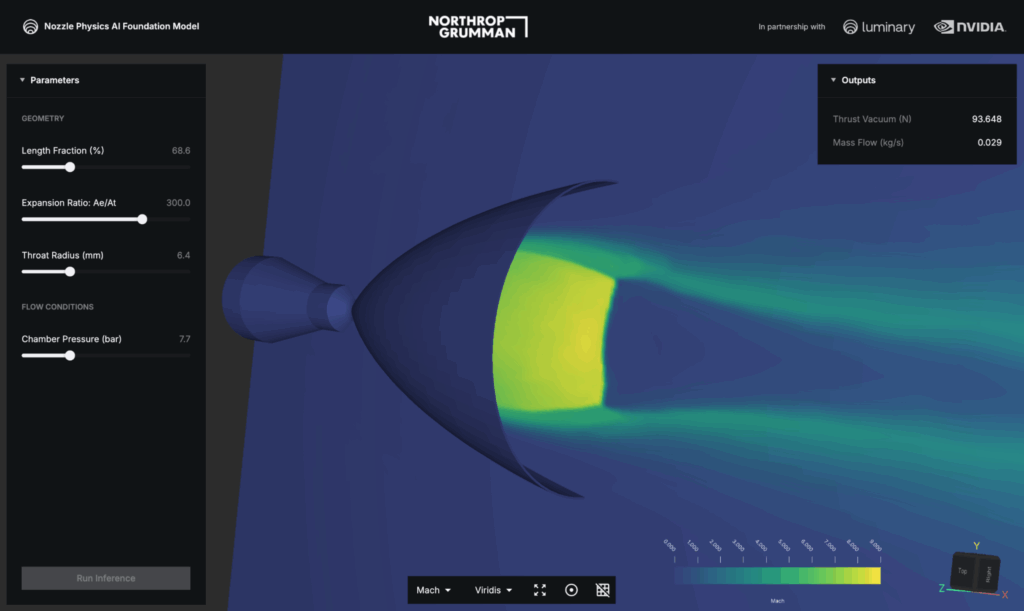
Physics AI platform Luminary Cloud and global aerospace and defence technology company Northrop Grumman have announced a partnership introducing the world’s first Physics AI foundation model for spacecraft system design and development, powered by NVIDIA’s PhysicsNeMo framework. Physics AI enables government and commercial organisations to radically compress design cycles, unlocking mission-critical capabilities and rapidly deliver next-generation systems.
The Physics AI foundation model represents a major advancement in shrinking development timelines from years to months. By reducing development and testing risk in propulsion systems, Northrop Grumman can deliver spacecraft faster, with greater performance and more robust safety margins. That acceleration has the potential to transform the cadence of innovation in both space exploration and national defence.
The new Physics AI model built by Northrop Grumman and Luminary Cloud with support from NVIDIA could dramatically speed design of components and, one day, entire spacecraft.
‘Physics AI is the next level of complexity in AI, and Northrop Grumman is bringing this technology to our design engineers to dramatically speed up hardware development,’ said Han Park, vice president, artificial intelligence integration, Northrop Grumman Space Systems. ‘Using AI to make something small, like a spacecraft thruster, puts us on a path to do much bigger things, like using AI to design larger components or even an entire spacecraft.’
Historically, aerospace programmes have relied on CPU-based computational fluid dynamics simulations to characterise aerodynamics and optimise propulsion subsystems – a process that can require months of compute time and budgets running into the millions. Northrop Grumman’s new foundation model reduces the analysis time for a single case from hours to seconds while preserving engineering-grade accuracy. This speed gives engineers the freedom to explore entire design spaces interactively and in real time.
The model demonstrates the capabilities of Luminary Cloud’s Physics AI platform, which unifies GPU-native simulation, large-scale dataset generation and model training into a single ‘Physics AI Factory’. Using this platform, vast quantities of high-fidelity simulation data are generated, the model is trained and the results are made accessible through a web-based application that enables engineers to evaluate performance on demand.

‘AI Physics is opening new frontiers in engineering,’ said Tim Costa, GM industrial and computational engineering at NVIDIA. ‘By leveraging NVIDIA accelerated computing and our PhysicsNeMo framework, Northrop Grumman and Luminary are demonstrating how AI Physics models can redefine the pace and scale of spacecraft design.’
According to Luminary Cloud, it’s expanding the possibilities for mission-critical productivity. The thruster nozzle AI foundation model offers transformational advantages to Northrop Grumman, including speed (teams can leverage Physics AI models to accelerate project schedules and deliver customer outcomes months to years faster than current simulation technology), scale (the model enables engineers to explore orders of magnitude more design candidates, allowing them to converge on higher-performing solutions) and accuracy (the model is trained on highly accurate physics simulation data to predict system performance with the precision required for spacecraft engineering).
‘Collaborating with Northrop Grumman to advance the state of simulation technology for rocket propulsion is a meaningful opportunity for our team. This announcement signals more than just a technical achievement – it is an invitation to reimagine the very process of spacecraft design to be faster, smarter and more adaptable,’ said Juan Alonso, CTO of Luminary. ‘By combining our Physics AI knowhow with Northrop Grumman’s deep engineering expertise, we’ve built a model that delivers speed, accuracy and trustworthiness for use in design exploration workflows. We look forward to expanding this collaboration on future programmes.’
As Physics AI models extend across propulsion and other subsystems, the industry will see traditional decade-long development cycles give way to an era of accelerated innovation from multiple sources, enabling humanity’s space ambitions to be realised on timelines once considered impossible.


